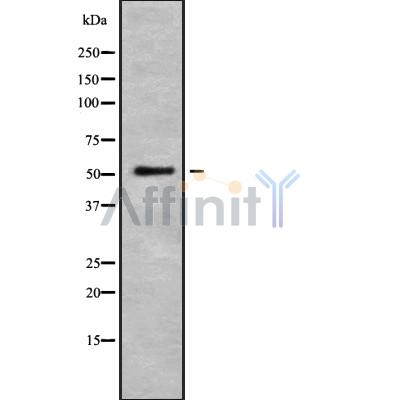5HT2A Receptor Antibody - #DF8900
| 製品: | 5HT2A Receptor Antibody |
| カタログ: | DF8900 |
| タンパク質の説明: | Rabbit polyclonal antibody to 5HT2A Receptor |
| アプリケーション: | WB IHC |
| Cited expt.: | WB |
| 反応性: | Human, Rat |
| 予測: | Pig, Bovine, Horse, Sheep, Rabbit, Dog |
| 分子量: | 52 kDa; 53kD(Calculated). |
| ユニプロット: | P28223 |
| RRID: | AB_2842096 |
製品説明
*The optimal dilutions should be determined by the end user. For optimal experimental results, antibody reuse is not recommended.
*Tips:
WB: For western blot detection of denatured protein samples. IHC: For immunohistochemical detection of paraffin sections (IHC-p) or frozen sections (IHC-f) of tissue samples. IF/ICC: For immunofluorescence detection of cell samples. ELISA(peptide): For ELISA detection of antigenic peptide.
引用形式: Affinity Biosciences Cat# DF8900, RRID:AB_2842096.
折りたたみ/展開
5 HT 2; 5 HT 2A; 5 HT2 receptor; 5 HT2A; 5 hydroxytryptamine receptor 2A; 5-HT-2; 5-HT-2A; 5-hydroxytryptamine (serotonin) receptor 2A, G protein-coupled; 5-hydroxytryptamine 2A receptor; 5-hydroxytryptamine receptor 2A; 5HT2A_HUMAN; HTR 2; HTR 2A; HTR2; HTR2, formerly; HTR2A; serotonin 5-HT-2 receptor, formerly; serotonin 5-HT-2A receptor; Serotonin receptor 2A;
免疫原
A synthesized peptide derived from human 5HT2A Receptor, corresponding to a region within the internal amino acids.
- P28223 5HT2A_HUMAN:
- Protein BLAST With
- NCBI/
- ExPASy/
- Uniprot
MDILCEENTSLSSTTNSLMQLNDDTRLYSNDFNSGEANTSDAFNWTVDSENRTNLSCEGCLSPSCLSLLHLQEKNWSALLTAVVIILTIAGNILVIMAVSLEKKLQNATNYFLMSLAIADMLLGFLVMPVSMLTILYGYRWPLPSKLCAVWIYLDVLFSTASIMHLCAISLDRYVAIQNPIHHSRFNSRTKAFLKIIAVWTISVGISMPIPVFGLQDDSKVFKEGSCLLADDNFVLIGSFVSFFIPLTIMVITYFLTIKSLQKEATLCVSDLGTRAKLASFSFLPQSSLSSEKLFQRSIHREPGSYTGRRTMQSISNEQKACKVLGIVFFLFVVMWCPFFITNIMAVICKESCNEDVIGALLNVFVWIGYLSSAVNPLVYTLFNKTYRSAFSRYIQCQYKENKKPLQLILVNTIPALAYKSSQLQMGQKKNSKQDAKTTDNDCSMVALGKQHSEEASKDNSDGVNEKVSCV
種類予測
Score>80(red) has high confidence and is suggested to be used for WB detection. *The prediction model is mainly based on the alignment of immunogen sequences, the results are for reference only, not as the basis of quality assurance.
High(score>80) Medium(80>score>50) Low(score<50) No confidence
研究背景
G-protein coupled receptor for 5-hydroxytryptamine (serotonin). Also functions as a receptor for various drugs and psychoactive substances, including mescaline, psilocybin, 1-(2,5-dimethoxy-4-iodophenyl)-2-aminopropane (DOI) and lysergic acid diethylamide (LSD). Ligand binding causes a conformation change that triggers signaling via guanine nucleotide-binding proteins (G proteins) and modulates the activity of down-stream effectors. Beta-arrestin family members inhibit signaling via G proteins and mediate activation of alternative signaling pathways. Signaling activates phospholipase C and a phosphatidylinositol-calcium second messenger system that modulates the activity of phosphatidylinositol 3-kinase and promotes the release of Ca(2+) ions from intracellular stores. Affects neural activity, perception, cognition and mood. Plays a role in the regulation of behavior, including responses to anxiogenic situations and psychoactive substances. Plays a role in intestinal smooth muscle contraction, and may play a role in arterial vasoconstriction.
(Microbial infection) Acts as a receptor for human JC polyomavirus/JCPyV.
Cell membrane>Multi-pass membrane protein. Cell projection>Dendrite. Cell projection>Axon. Cytoplasmic vesicle. Membrane>Caveola. Cell junction>Synapse>Presynapse.
Detected in brain cortex (at protein level). Detected in blood platelets.
The PDZ domain-binding motif is involved in the interaction with PATJ, CASK, APBA1, DLG1 and DLG4.
Belongs to the G-protein coupled receptor 1 family.
研究領域
· Cellular Processes > Cellular community - eukaryotes > Gap junction. (View pathway)
· Environmental Information Processing > Signal transduction > Calcium signaling pathway. (View pathway)
· Environmental Information Processing > Signaling molecules and interaction > Neuroactive ligand-receptor interaction.
· Organismal Systems > Nervous system > Serotonergic synapse.
· Organismal Systems > Sensory system > Inflammatory mediator regulation of TRP channels. (View pathway)
参考文献
Application: WB Species: Mouse Sample:
Restrictive clause
Affinity Biosciences tests all products strictly. Citations are provided as a resource for additional applications that have not been validated by Affinity Biosciences. Please choose the appropriate format for each application and consult Materials and Methods sections for additional details about the use of any product in these publications.
For Research Use Only.
Not for use in diagnostic or therapeutic procedures. Not for resale. Not for distribution without written consent. Affinity Biosciences will not be held responsible for patent infringement or other violations that may occur with the use of our products. Affinity Biosciences, Affinity Biosciences Logo and all other trademarks are the property of Affinity Biosciences LTD.


